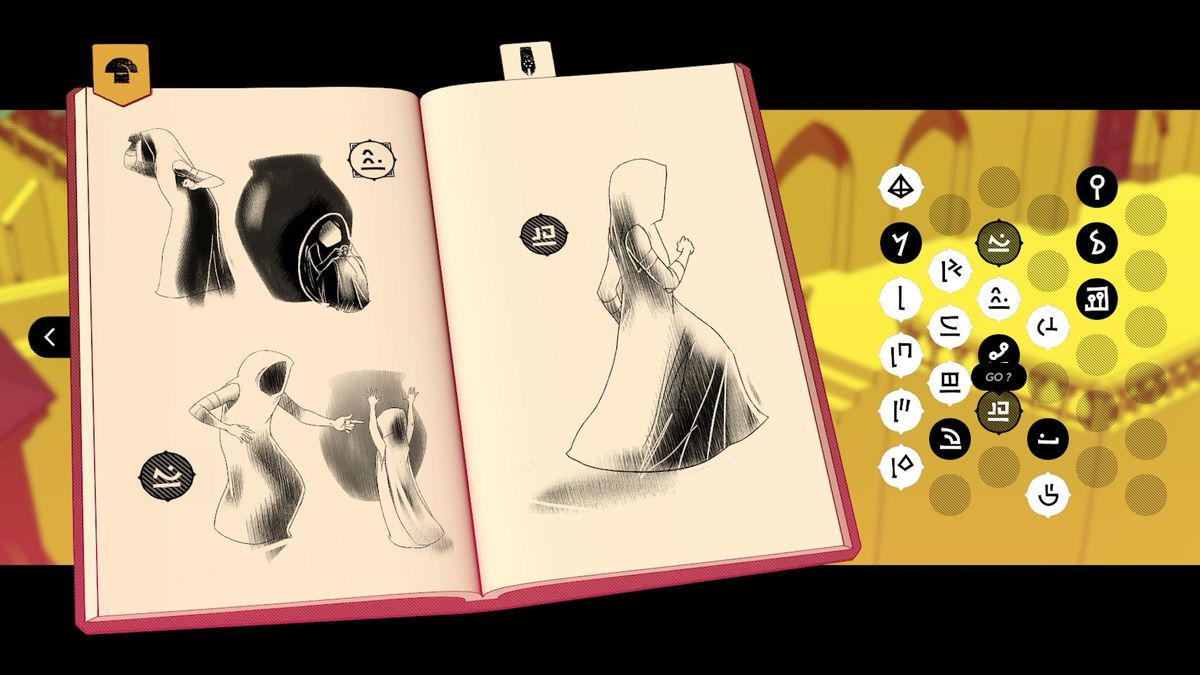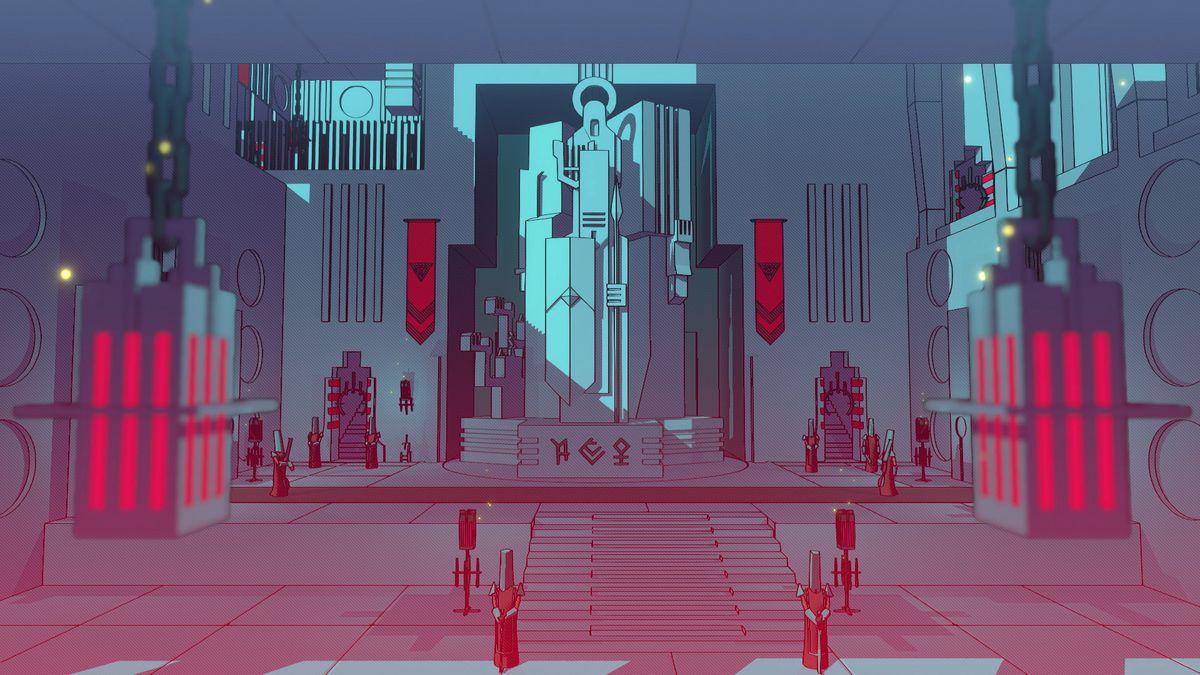Early on in Chants of Sennaar, in a walled garden, someone spoke to me in a language I couldn’t understand. From their posture and the shaking of their head, though, it was clear they were speaking about the dead plant standing next to them. An hour later, I’d come back to this conversation with more knowledge and understand everything they had to say. But this first time, although I missed some important context, I got the gist, and I sympathized; I’ve killed my share of plants, too.
Chants of Sennaar is a language-based puzzle game based on the biblical story of the Tower of Babel. In this retelling, your character makes their way through five floors of a tower, each of which is home to a different community with a different language. Using a pictorial journal, you assign every word you find to a picture, slowly piecing together each language as you go. You use the words you learn to solve other puzzles, navigate the tower, and understand what others are saying. All this is made possible through decoding language — and I can’t overstate how fun the process is.
The game runs beautifully on Switch, assuming you can put up with some annoying autocorrects (not the game’s fault) when you’re writing in your journal. The huge vertical towers and tiled corridors that make up the backgrounds are stunning, and the Middle Eastern architecture effectively communicates each community’s atmosphere, from an imposing gated castle to a laid-back, artistic city with a dark secret.

The other characters you encounter on your journey are crucial to moving forward. Early in the game, a wanderer asks you to open a door before doing the same for you, excusing themselves, and bowing before they fade away. At every turn, Chants of Sennaar eases you into its puzzles through the mysteries and revelations of language. Although these characters have no backstory besides the specifics of their culture, their contributions to your quest to ascend the tower give them a sense of being co-conspirators or antagonists; for example, a group of masked bards who laugh at you wordlessly foster resentment, while an animal sidekick might make you laugh.
A lesser game would make every single character into a mere puzzle piece, but developer Rundisc refuses to do so, and you engage someone in simple conversation as frequently as you talk to them to solve a puzzle. These conversations create the same magic feeling that comes when you’re learning a new language and you first realize you can utter a full sentence: Knitting together words into actual expression is intoxicating, even if you’re just listening to someone lament their dead plant. Even when you’re not speaking, you can come across people playing music or making pottery. The world of the tower feels alive.

Chants of Sennaar’s lowest points lie in the puzzles where you get stuck, and Rundisc gives you the most redundant of hints as to how to move forward. Sometimes these challenges were appreciated, as I got to figure out the way forward for myself. Other times I wished there was a stronger sense of direction. When you’re crushing the puzzle solving, the game flows; as soon as you get stumped, it slows to a backtracking halt.
This loop is perforated by stealth sections where you avoid enemies that want to kick you out of the tower. I’m not a fan of mandatory stealth modes, and I’m especially not a fan of trying to solve linguistic puzzles while I’m sneaking. And if the puzzles are the most difficult part, the stealth is no slouch, either — some levels feel a little ridiculous due to imprecise controls. However, frustrating as they are, the stealth sections do liven up the game’s pacing. Plus, they have the holy grail of stealth level mechanics — instant resets from the same room — so I could never be too mad when I got caught. The game also features fast travel points so you can bypass most of the stealth sections you’ve already completed.

When Chants of Sennaar is on a roll, there’s really nothing else like it. And when it gets tedious, it never remains so for very long. But I think fun is the wrong metric for this game. Is viewing ancient Egyptian sculpture fun? Is reading Ovid or Virginia Woolf? For that matter, is learning a language? Sometimes. But we do these activities to experience a different kind of pleasure: accessing a shared understanding of what it means to be human, across barriers of time and interpretation.
Chants of Sennaar folds every one of its puzzle-solving bricks into a Rubik’s Cube of a concept, and yet it revels most of all in pan-linguistic understanding. The figure taking their break on a roof, or the grunted “no” from a security guard, or the laughter of a child playing hide-and-seek all serve to remind you of your place in a community. Learning a language stands in for observing and appreciating a culture that’s unfamiliar to you. It’s a lofty goal for a game, and it’s one that Chants of Sennaar achieves.
Chants of Sennaar was released on Sept. 5 on Nintendo Switch, PlayStation 4, Windows PC, and Xbox One. The game was reviewed on Switch using a pre-release download code provided by Focus Entertainment. Vox Media has affiliate partnerships. These do not influence editorial content, though Vox Media may earn commissions for products purchased via affiliate links. You can find additional information about Polygon’s ethics policy here.
- SEO Powered Content & PR Distribution. Get Amplified Today.
- PlatoData.Network Vertical Generative Ai. Empower Yourself. Access Here.
- PlatoAiStream. Web3 Intelligence. Knowledge Amplified. Access Here.
- PlatoESG. Automotive / EVs, Carbon, CleanTech, Energy, Environment, Solar, Waste Management. Access Here.
- PlatoHealth. Biotech and Clinical Trials Intelligence. Access Here.
- ChartPrime. Elevate your Trading Game with ChartPrime. Access Here.
- BlockOffsets. Modernizing Environmental Offset Ownership. Access Here.
- Source: https://www.polygon.com/reviews/23864920/chants-of-sennaar-review-puzzles-stealth
- 1
- 220
- 28
- 7
- 8
- 9
- a
- About
- accessing
- Achieves
- across
- activities
- actual
- Affiliate
- All
- already
- also
- Although
- an
- ancient
- and
- animal
- architecture
- ARE
- artistic
- as
- ascend
- At
- Atmosphere
- avoid
- away
- back
- backgrounds
- barriers
- based
- BE
- beautifully
- before
- being
- below
- besides
- BEST
- break
- but
- by
- CAN
- caught
- challenges
- character
- characters
- child
- City
- clear
- code
- come
- comes
- commissions
- community
- completed
- concept
- content
- context
- contributions
- controls
- Conversation
- conversations
- could
- create
- crucial
- Culture
- Dark
- dead
- Developer
- different
- difficult
- direction
- do
- doing
- door
- download
- due
- each
- Early
- Earn
- eastern
- Editorial
- effectively
- either
- else
- engage
- Entertainment
- especially
- ethics
- even
- Every
- everything
- Example
- experience
- expression
- fade
- fan
- FAST
- fault
- Features
- feel
- Figure
- figures
- find
- First
- first time
- five
- floors
- flows
- Focus
- Focus Entertainment
- folds
- For
- Forward
- foster
- frequently
- from
- frustrating
- full
- fun
- game
- Gaming
- Garden
- gated
- Get
- give
- gives
- go
- goal
- Grail
- Group
- guard
- had
- has
- Have
- head
- hints
- Home
- hour
- How
- How To
- however
- http
- HTTPS
- huge
- human
- i
- if
- important
- imposing
- in
- influence
- information
- instant
- into
- Is
- IT
- ITS
- journal
- journey
- jpg
- just
- kick
- kind
- knowledge
- language
- later
- laugh
- LEARN
- learning
- lesser
- Level
- levels
- lie
- like
- links
- Listening
- Little
- Long
- lowest
- made
- Magic
- make
- MAKES
- Making
- mandatory
- matter
- May
- me
- means
- Mechanics
- Media
- mere
- metric
- Middle
- might
- missed
- modes
- more
- most
- move
- move forward
- moving
- Music
- my
- navigate
- never
- New
- Newsletter
- Next
- Nintendo
- Nintendo Switch
- no
- not
- notes
- nothing
- of
- on
- One
- open
- or
- Other
- Others
- out
- part
- partnerships
- Patch
- patch notes
- PC
- People
- picture
- piece
- place
- plants
- plato
- plato data intelligence
- platodata
- platogaming
- Playing
- playstation
- playstation 4
- Plus
- Point
- Points
- policy
- Polygon
- possible
- Process
- Products
- provided
- purchased
- put
- Puzzle
- puzzle game
- quest
- Reading
- realize
- really
- released
- remains
- Roll
- roof
- room
- roundup
- runs
- same
- say
- saying
- Secret
- security
- sense
- sept
- serve
- several
- Share
- shared
- sign
- Simple
- single
- So
- solution
- SOLVE
- Solving
- some
- someone
- Soon
- Speaking
- specifics
- stand
- standing
- stands
- Stealth
- Story
- stronger
- Stunning
- Switch
- taking
- talk
- that
- The
- The Game
- the world
- their
- Them
- themselves
- there
- These
- they
- things
- think
- this
- though
- Through
- time
- times
- to
- together
- too
- travel
- turn
- Understand
- understanding
- unfamiliar
- up
- use
- using
- vertical
- very
- via
- View
- viewing
- virginia
- W3
- Walled
- want
- was
- way
- we
- weekly
- were
- What
- when
- where
- while
- WHO
- windows
- Windows PC
- with
- words
- world
- would
- writing
- wrong
- xbox
- Xbox One
- XML
- yet
- you
- your
- zephyrnet












